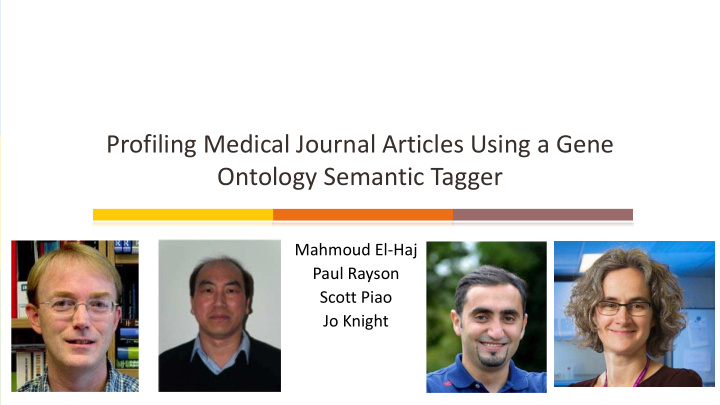



Profiling Medical Journal Articles Using a Gene Ontology Semantic Tagger Mahmoud El-Haj Paul Rayson Scott Piao Jo Knight
Origin and Outcomes Currently funded through a Wellcome Trust Seed award Collaboration with UCREL through DSI International Genetic Epidemiology Society 2017 - Poster presented Language Resources Evaluation Conference 2018 - Paper accepted Talks Valencia (Paul) /DSI (Jo) Future - Section of and EPSRC Grant with Richard Harper ISF
Introduction Goal of Human Medical Genetics
Introduction Goal of Human Medical Genetics Literature explosion The need to adapt NLP and Corpus Linguistic methods
Dataset Medical journal abstracts from PubMed English articles discussing human genetics studies in psychiatry and immune related disorders.
Dataset Corpus #Articles #Words Keywords Immune 21.5K 4.8M (geneti* OR gene OR genot*) AND (immunol* OR immunog* OR immune) Psychiatric 15.2K 2.8M (geneti* OR gene OR genot*) AND (psychi) Reference 296.5K 79.0M (geneti* OR gene OR genot*) Total 333.2K 86.7M
Data Extraction Search PubMed website directly Saved results to large XML file Built a Java Suite for parsing PubMed XML file format. Java suite extracts abstracts, titles, authors, pub-date, DOI …etc. Code freely available on github: https://github.com/drelhaj/BioTextMining
Fine-grained Medical Terms Words in pubmed just aren't the same...cytokines, lymphocyte mediated immunity Extra level of annotation required for tagging The Gene Ontology Consortium's 1 OBO Basic Gene Ontology (go- basic.obo) categories 2 . _________________ 1 http://geneontology.org/ 2 http://purl.obolibrary.org/obo/go/go-basic.obo
What is GO? Gene Ontology (GO) : consistent descriptions of gene products across databases. go-basic.obo : is the basic version of the GO ontology, filtered such that the graph is guaranteed to be acyclic paths, Annotations can be propagated up the graph. We focused on the is_a relation in order to trace ancestors and children for each entry in the ontology.
Gene Ontology Semantic Tagger (GOST) Corpora uploaded to Wmatrix POS tagged using CLAWS. Semantically tagged using USAS Counted frequencies Compared sub-corpora using methods from Corpus Linguistics.
Parsing OBO we created Java code that combines the use of publicly available OBO library 1 with Java Directed Graph (Digraphs) to trace the paths from a node child to the root. The code used Breadth First and Depth First algorithms to quickly and accurately extract the paths. _________________ 1 https://github.com/sugang/bioparser 2 http://purl.obolibrary.org/obo/go/go-basic.obo
OBO Graph Sample Our code allowed us to generate a USAS tagger dictionary file where each entry in the OBO ontology is tagged with the GO IDs shown in its path. In the figure we can see two paths from the child node towards the ``biological process'' root.
Dictionary Creation The dictionary creation process works as follows: 1. Is child node single word or multi-word expression. 2. get number of paths towards the root. 3. get each path's GoID entries (child node's ancestors) 4. include the level of each ancestor by adding that to the end of each entry (e.g. .1 to refer to the first parent (GOO:0002251). 5. Check if path passes through an ``immune system process'‘ (i.e. GoID: 0002376). 6. If so we add .I to the end of the GoID tag to refer to immune entry, otherwise we add .N referring to a non-immune entry.
Tagging Example Following the steps in previous slide, the child node GO:0002385 is multi-word expression entry with following semantic dictionary tags: {GO:0008150.4.I, GO:0002376.3.I, GO:0050896.3.N, GO:0006955.2.I, GO:0002385.0.I, GO:0002251.1.N, GO:0006955.2.N, GO:0002385.0.N, GO:0002251.1.I, GO:0008150.4.N}.
Tagging Example Tags such as GO:0006955 ends with .2 suffix referring to level two (counting from level zero). and will appear twice; once as an immune entry with a .I suffix (GO:0006955.2.I) and another as a non-immune entry with a .N suffix (GO:0006955.2.N).
Complex Example Dictionary creation can be complex Overlapping hierarchies Levels that can be skipped
GOST The resultant GO term and ID map collection from the process described above contains: 433 single word bioterms and 44,180 multiword bioterms merged into the Lancaster UCREL Semantic lexicons to create a new version of the Lancaster USAS semantic annotation system named: “GOST” (Gene Ontology Semantic Tagger)
Using The GOST Using the GOST, we have tagged 237,615 PubMed abstracts in our corpus. This corpus provides a valuable new resource for mining Biomedical and health information from the Biomedical literature. The table shows a sample from a tagged abstract, where the part-of-speech tags are from CLAWS C7 tagset the generic semantic tags are from the USAS tagset, and the MWE tags encode multiword term information including sequential number, term length and location of each word in the given term.
Results – word comparison
Results – word comparison next level down Less predictable words such as "risk'' Language is used different despite both corpora describing genetic studies of a complex trait
Results - new GOST annotated corpora
Conclusion and Future Work A method for the creation of a semantic lexicon from an existing Gene Ontology, a Gene Ontology Semantic Tagger (GOST) Applied to corpora of scientific papers Provided a freely available annotated corpora Demonstrated the tools extending corpus and computational linguistics allows genomics researchers to get sensible answers
Resources The corpora and Java code to parse and annotate the dataset in addition to the ontology lexicon are made publicly available for research purposes. https://github.com/drelhaj/BioTextMining The Gene Ontology Semantic Tagger will soon be released via the downloadable graphical interface. http://ucrel.lancs.ac.uk/usas/gui/ Project information http://wp.lancs.ac.uk/btm/
Recommend
More recommend